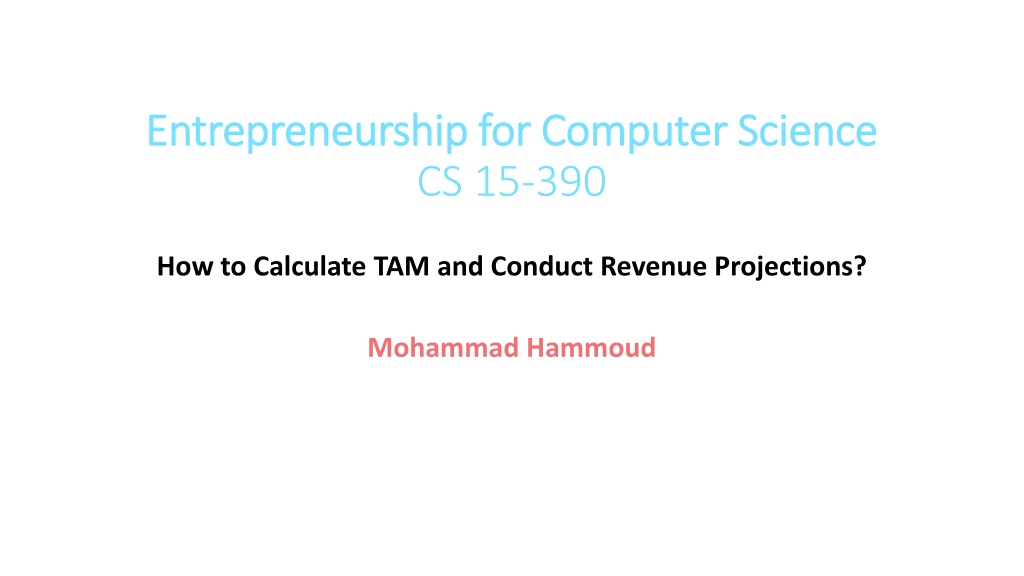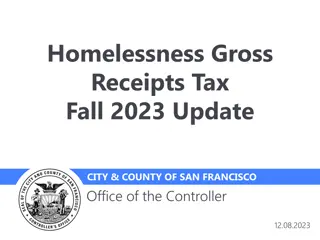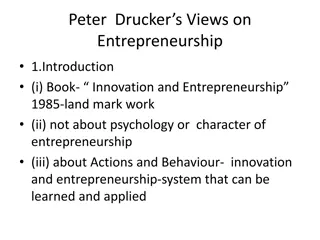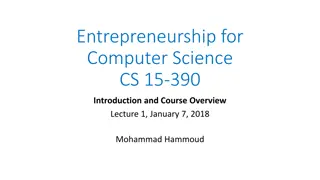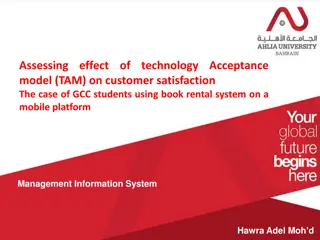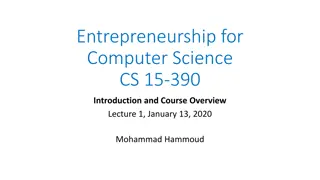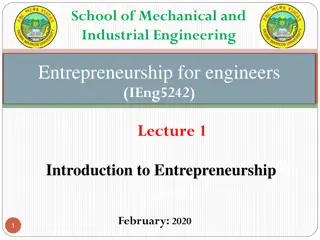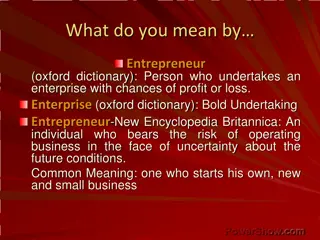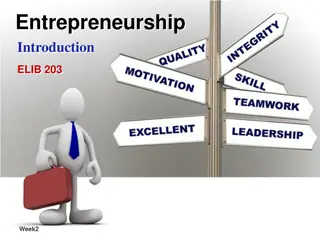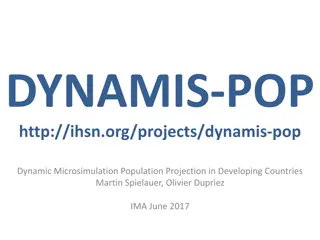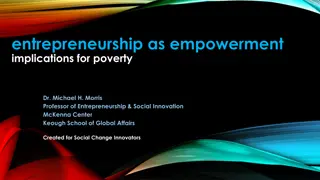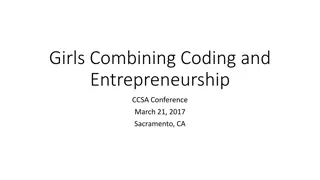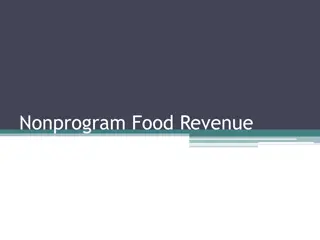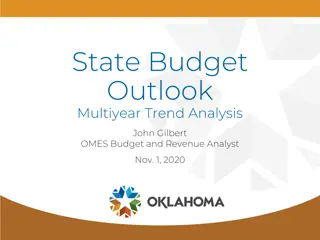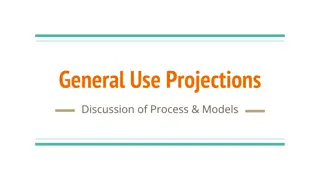How to Calculate TAM and Conduct Revenue Projections for Entrepreneurship in Computer Science
Understanding Total Addressable Market (TAM) is crucial for startups in Computer Science entrepreneurship. TAM signifies the potential revenue a company could generate by capturing 100% market share. Calculating TAM involves considering factors like the number of potential customers and estimated average revenue per customer annually. This process acts as a sanity check ensuring the business is on the right track. An example of a Shoe E-Commerce Platform illustrates TAM calculations with factors such as maximum possible number of orders and average order price.
Download Presentation

Please find below an Image/Link to download the presentation.
The content on the website is provided AS IS for your information and personal use only. It may not be sold, licensed, or shared on other websites without obtaining consent from the author. Download presentation by click this link. If you encounter any issues during the download, it is possible that the publisher has removed the file from their server.
E N D
Presentation Transcript
Entrepreneurship for Computer Science Entrepreneurship for Computer Science CS 15-390 How to Calculate TAM and Conduct Revenue Projections? Mohammad Hammoud
What is Total Addressable Market (TAM)? TAM is the amount of annual revenue your company would make if it captures 100% share of the market in question Sweet Spot big enough to get positive cash flow Danger too big; veer to your left Uninteresting too small Beachhead TAM calculation is your sanity check that you are headed in the right direction
Calculating TAM TAM is mainly based on the following two factors: 1. The total number of potential customers who may use your product per year Depends on the number of potential customers and the average frequency of orders by any customer E.g., For an app that enables patients to book appointments with physicians, you need to figure out the total number of patients that are likely to use the app and the average number of times patients visit doctors per year 2. The estimated average revenue per customer per year Depends on the business model E.g., For an app that enables patients to book appointments with physicians and uses a transaction-based model, you need to figure out the average price per session per physician and take a cut (e.g., 10%) out of it TAM is simply the multiplication of the above two factors
Example: A Shoe E-Commerce Platform Assume an e-commerce platform that sells shoes online The platform does not own any inventory, but rather partners with existing shoe stores The platform does not own a delivery fleet, but rather partners with existing delivery companies Business model: 8% of any order (which may contain 1 or many shoes) as a transaction fee from every partner store $5 convenience fee from any customer to deliver their order Average Revenue Per Order = (0.08 average order price) + $5
Example: A Shoe E-Commerce Platform Two required factors: The maximum possible number of orders Can be calculated by multiplying: The total number of people who may buy shoes (can be figured out through market research) The expected number of orders per year per person (can be identified through market research) Say, for example, it turned out to be 1,000,000 orders per year The estimated average price per order Say, for instance, $35
Example: A Shoe E-Commerce Platform TAM = Estimated # of orders Estimated revenue per order = 1,000,000 ((0.08 35) + 5)) = $7,800,000 Hint: If TAM < $5 million, it is possible that your venture has not identified a big enough beachhead market $5 million < TAM < $100 million is usually a reasonable TAM Anything over $1 billion may (but not necessarily) raise flags
Example: A Shoe E-Commerce Platform How much of the TAM would the platform capture every year (or how much revenue would the platform make every year)? This is referred to as revenue projections, whichcan be fully formalized via developing a mathematical model and conducted over multiple future years Factors and mathematical model (stemmed from the business model): Estimated # of orders = N Market share = Average order price = P Transaction fee = Convenience fee = Then, the mathematical model = ( N) ( P + )
Example: A Shoe E-Commerce Platform Alongside, you can vary the market share ( ) and observe how the projected revenue will change accordingly Revenue Projection Model Revenue Projection Model Revenue Projection Model Revenue Projection Model (( N) ( P + )) (( N) ( P + )) (( N) ( P + )) (( N) ( P + )) Number of Orders (N) Orders (N) Orders (N) Orders (N) Number of Number of Number of Market Share ( ) Share ( ) Share ( ) Share ( ) Market Market Market Transaction Fee ( ) Fee ( ) Fee ( ) Fee ( ) Transaction Transaction Transaction Order Price (P ) Price (P ) Price (P ) Price (P ) Order Order Order Convenience Fee ( ) Fee ( ) Fee ( ) Fee ( ) Convenience Convenience Convenience TAM TAM TAM TAM 1,000,000 1,000,000 1,000,000 1,000,000 1,000,000 1,000,000 1,000,000 1,000,000 1,000,000 1,000,000 1,000,000 1,000,000 1,000,000 1,000,000 1,000,000 1,000,000 1 1 1 1 0.08 0.08 0.08 0.08 0.08 0.08 0.08 0.08 0.08 0.08 0.08 0.08 0.08 0.08 0.08 0.08 35 35 35 35 35 35 35 35 35 35 35 35 35 35 35 35 5 5 5 5 5 5 5 5 5 5 5 5 5 5 5 5 $7,800,000 $78,000 $78,000 $7,800,000 $78,000 $156,000 $156,000 $156,000 $7,800,000 $78,000 $156,000 $390,000 $390,000 $390,000 $390,000 $7,800,000 0.01 0.02 0.02 0.02 0.01 0.01 0.01 0.02 0.05 0.05 0.05 0.05 You can further vary any variable in the model and observe how the projected revenue will change accordingly This is referred to as sensitivity analysis
Example: A Shoe E-Commerce Platform Sensitivity Analysis: Market Share ( ) = 5% Market Share ( ) = 10% 600000 1200000 512500 1025000 425000 850000 500000 1000000 Revenue ($) Revenue ($) 390000 780000 400000 800000 300000 600000 200000 400000 100000 200000 0 0 0.08 0.1 0.15 0.08 0.1 0.15 Transaction Fee ( ) Transaction Fee ( ) When conducting revenue projections over multiple years, you would typically increase the market share every year by a certain %
The China Syndrome You might be inclined to choose a big existing market, assuming that you can easily acquire a tiny fraction of it and reap the rewards! This is referred to as the China Syndrome For example, if you can capture 0.1% of the toothbrush market in China (population ~1.5 billion), would not you make a lot of money? How would the logic go?
The China Syndrome The logic goes as follows: A reputable site on the Internet says that China has ~1.5 billion people If 1 billion of these people have teeth, the market size would be 1 billion customers You can build a toothbrush for the Chinese market and potentially capture 0.1% market share in the first year If each person buys 3 toothbrushes per year, you could sell 3 million toothbrushes per year If you sell each toothbrush for $1, you would have $3 million in sales the first year, with lots of room to grow! Is there any problem with this logic?
The China Syndrome This logic has several gaps: It did not demonstrate in a compelling manner the reasons of why people will buy your toothbrush and not other toothbrushes It assumed that you would capture 0.1% of the market share in the first year; how? How can you distribute your toothbrushes in all China in the first year? Have you sold any toothbrush so far? If you are selling to wholesalers (who then sell to retailers), what have been your closing rate? Even if you haven t sold to any wholesaler, have you met with any and gotten a sense if they would buy from you? What if the wholesaler buys, sells to retailers, and people end up not buying your toothbrush from the retailers?
Principle 9: Under-Project and Over-Deliver If entrepreneurship is that easy, would not everyone sell toothbrushes in China? Do not get ensnared by The China Syndrome Do your revenue projections only after: You do extensive primary & secondary market research You test your product with targetaudience and evolve it (recall the lean approach) You figure out the right business model for selling your product You figure out the sales process and distribution channels in detail Your projections will always be only estimations, but the harder you try to be accurate, the more you will be close to being accurate Better to under-promise and over-deliver
